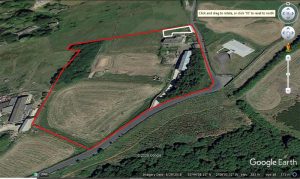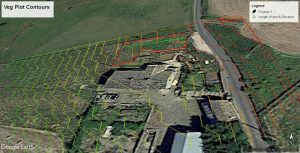Creating a fertile growing area in an exposed location (The Veg Plot)
Theme Tune – Isolation – John Lennon
Introduction
2020 was the year I was going to focus on other areas of the farm. It was the year I was going to leave the proposed veg plot fallow, adding lots of mulch and manure to try to ‘grow’ more humus.
Then Covid-19 struck the world and my priorities shifted. Growing food for my family and sharing with neighbours became a higher priority.
Work & school were cancelled, what better time to get growing and (try to) get the kids involved in the process.
Vision
To implement mechanisms that allow me to grow vegetables and fruit in an area that has thin, poor soil and is exposed to strong winds. The crops must be things that my family like to eat. Creating a blanace between having productive harvests and encouraging biodiversity. Plot must be minimal maintenance.
Ethics
Earth Care – Use No-Dig methods. Compost biomass, Sow wildflowers and companion plants to feed pollinators. Brew Compost Teas. Mix Perennial & Annual Veg plants. Mini-swales will ensure rainwater stays in the area as long as possible.
People Care – Grow food we want to eat; Minimal maintenance once constructed. Income stream from selling preserves/veg at the gate. Share knowledge with others.
Future Care– Any over abundance will be shared with our neighbours and friends, either fresh or as preserves. Seeds & knowledge saved and passed on to others. I will ecourage young people to voluteer with me..
Principles used to guide design
Mollison & Slay’s principles
Relative location ; Each element performs many functions; Each important function is supported by many elements; Efficient energy planning: zone, sector & slope; Using biological resources; small-scale intensive systems; inc plant & time stacking; Accelerating succession and evolution; Diversity inc. Guilds; Edge effect; Imagination and information intensive
Design Framework – SADIMET
Survey, Analyse, Decisions, Implement, Maintain, Evaluate, Tweak
Client
My family and myself
Dates
March 2020 – November 2020 (Design & Phase 1 Implementation)
Tools Used
A-Frame & Spirit level, Base Maps & Overlays, Google Earth (Measuring), AH Contour Generator, McHargs Exclusion, Sector SWOC Analysis, Venn Diagram of Veg, Incremental Design
Methods Used
Walking the site, Seasonal observations over several years
Resources Used
Google Earth, Patrick Whitefield – Earth Care Manual, Jasmine Dale – Permaculture Design Companion
Link to Personal Objectives
This designs helps me to fulfil the below objectives
- Become fluent in the use and application of design tools and Permaculture principles
- Become confident enough to demonstrate and explain to others how Permaculture can be applied to both land non-land based projects
- For my designs to be easily read and understood by someone new to the concept of Permaculture
- To improve my drawing skills (freehand and computer)
Yields this project will provide
- Practicing mapping techniques
- Practicing surveying techniques
- A better understanding of how I plan and implement projects
- A diploma design
- Fruits, vegetables, seeds
- Techniques for growing crops in ‘marginal lands’
- Better understanding of growing crops
Survey
Tools & Methods Used – Google Earth, Walking the site, Seasonal observations over several years, Base Maps & Overlays,
I used the 4 elements (Earth, Air, Fire, Water) plus Wild to help form my survey.
Earth
Situated approximately 270m above sea level. (Source Google Earth and https://en-gb.topographic-map.com/)
Land slopes towards the west. Using Google Earth I discovered that the land had a 20% slope. Not as steep as the Hazel Plantation below the plot, but still fairly steep.
I used the AH Contour Generator app used to find contours and apply to Google Earth Map.
Soil is thin, stony and patchy. Heath like terrain. Depth generally 0.25/0.5 spade depth. 4 years ago some ‘top soil’ was spread on the site. It was very poor quality and blew away/washed away quickly. Green manures were sown, White clover was the only one to take and this has been cut as mulch since. Manure has also been added to the soil as mulch, so it has improved a little.
Soil dries out quickly, and becomes very hard.
Road above the site to the east, House is below the site to the South and there is a field with Ponies to the North. The Northen edge has a dry stone wall as well as sheep netting.
Plants in existence. Newly planted fruit trees, Docks, Coltsfoot, Nettles, Grasses and White Clover. Bilberry bushes have self sown behind greenhouse.
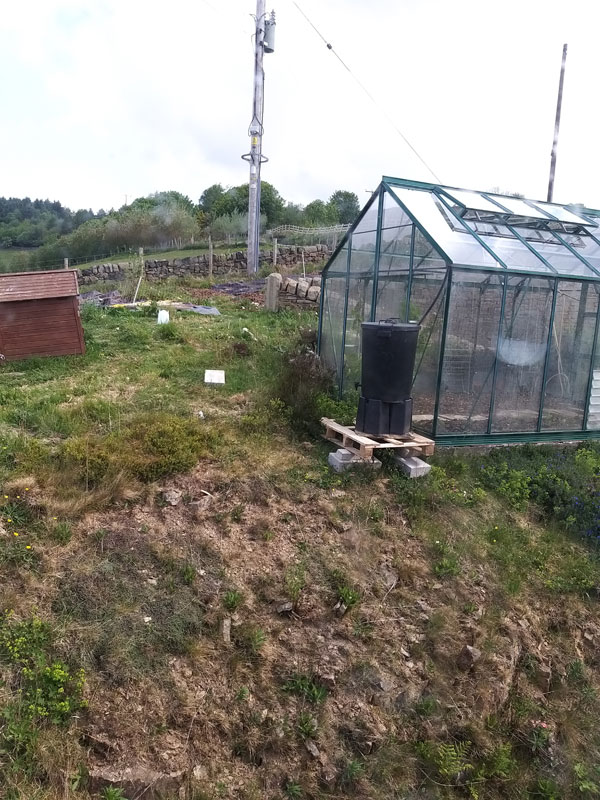
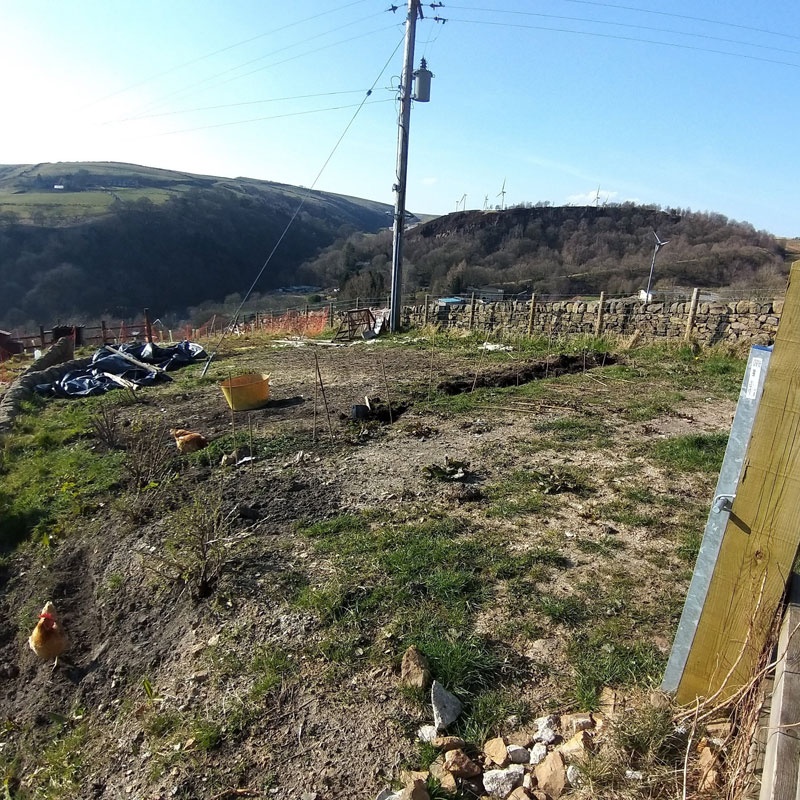
Air
The site is very exposed with little wind protection.
W/SW wind is the prevailing direction.
Also exposed to N & E & S winds.
There is an amazing view of the valley to the West and the North
Video demonstrating the wind pattern as the wind funnels round this sie of the house.
Fire
The site receieves full sun, all day, all year round. Slight shade provided on Southern edge by the low stone wall.
The warmest month of the year is July, with an average temperature of 16.2 °C | 61.2 °F. January has the lowest average temperature of the year. It is 3.3 °C | 37.9 °F.
First/Last frosts Mid-October / Mid-May
Water
1093 mm per year (average). The driest month is usually May, with 70 mm | 2.8 inch of rainfall. With an average of 119 mm | 4.7 inch, the most precipitation usually falls in December.
No water on site.
Water butts attached to greenhouse below site, as well as water pipes (Not yet plumbed in).
Outdoor tap attached to house below site. A long hose can reach the site.
In flood events, water pours off the road through the site. This happens once or twice a year, but becoming more frequent. Video of flood footage.
The soil does not hold water well, and being a slope, drains quickly.
Wild
Pests – Moles, Badgers, Deer, Voles, Mice, Caterpillars
Major Pest – Slugs, slugs and more slugs.
Chickens & our dog who likes to ‘help’
Existing Features & resources
- Stone Walls & Sheep fencing – North, Small Stone wall – South
- Wooden Fences – East & West edges, large gate to East.
- Electricity pole & guide line in middle of site.
- Greenhouse below site
- Access to manure
- Homemade compost
- Fruit bush cuttings & exisiting veg seeds
- Cool barn with secure space to store food (Not shown on maps)
- I have preserving (Pickling/drying/fermenting) knowledge
Basemap & Sector Analysis & McHargs exclusion
I used Google Earth to create the Base Map, but also measured on the ground. The two measurements did not quite correspond. Having read into it, it is due to the slope of the land. I have more space available than the Satellite images show. I therefore re-measured manually using a tape measure, and re-drew the base map.
I did not include sun in the Sector Analysis. The site receives full sun, all day, all year round. There are no shade areas.
I used McHargs exclusion method to investigate best areas to plant trees and taller shrubs. The postion of walls, the greenhouse, the gate opening and the guide wire for the electricity pole all defined possible growing and tree planting areas..
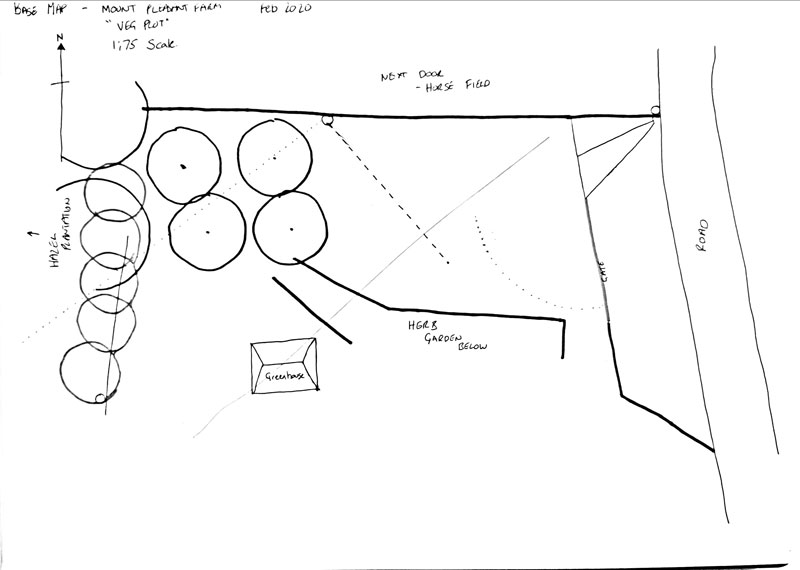
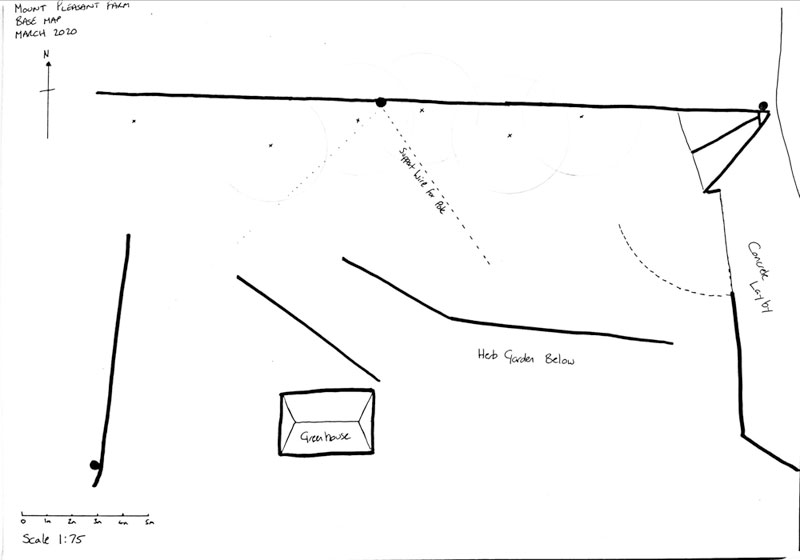
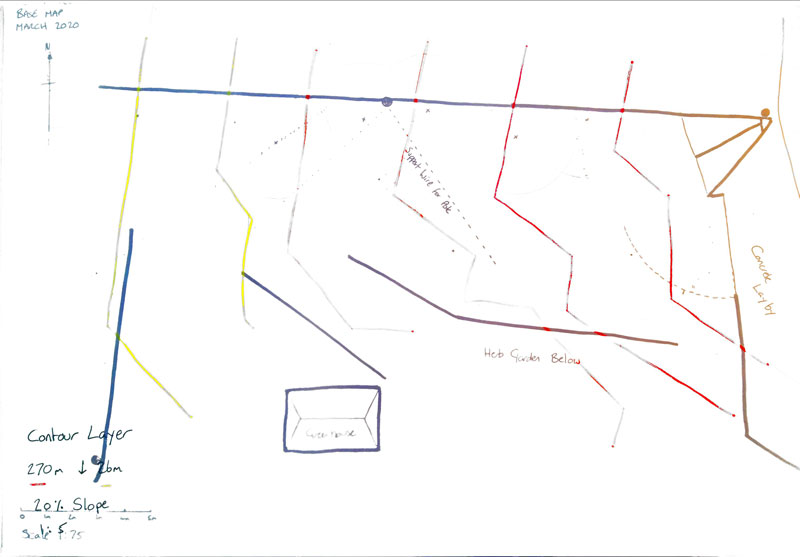
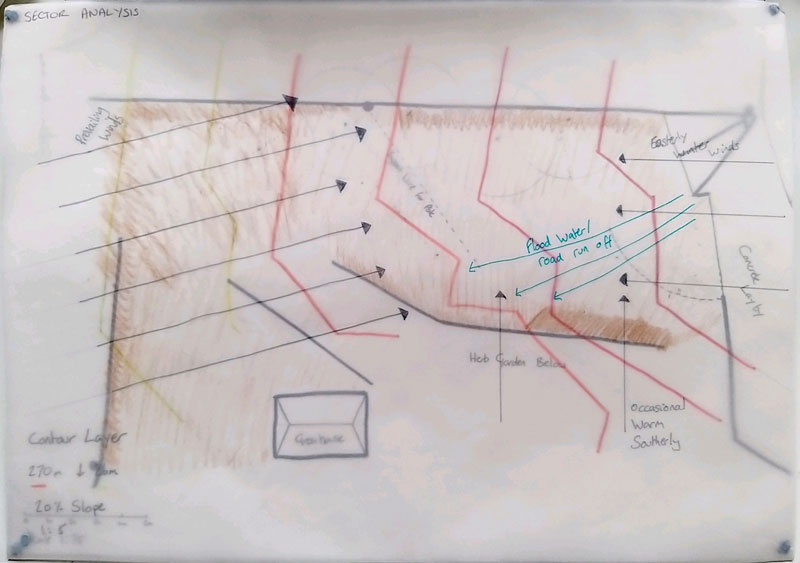
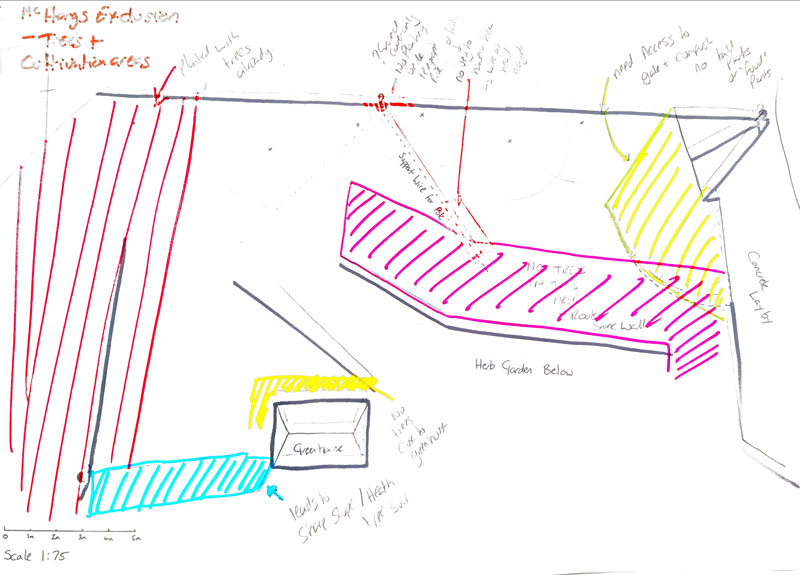
SMART Goals
Based on the work I did with my survey, I set myself a few SMART (Specific, Measurable, Achievable, Relevant & Timebound) goals for this project. These will help me evaluate whether the project has been successful.
In 2022, I will have enough knowlege about the site to confidently host a group of volunteers. I aim to have group that meets weekly. I want the group to grow organically, through word of mouth and have at least 5 regular volunteers by the harvest season.
In 2022, I will start to keep proper crop & harvest records, as well as compost tea brews & applications, which will enable me to track my success (or otherwise). These will form the observations needed for plantings in years to come.
By the end of 2023, I will produce enough fruit and vegetables from my plot that I will not need to order a regular veg bag, we will be self sufficient over the most productive months for most fruit and vegetables.
By 2024 I will be self sufficient in creating my own mulch for this growing area.
By 2025 I will better be able to see whether the trees I have planted to act as wind buffers are working. At this point I will be able to see what tweaks need to be made.
Analyse
Tools Used – Sector SWOC Analysis, Venn Diagram of Veg
Sector SWOC Analysis
Earth
| Strengths Drains Well Chickens have cleared some areas of weeds and pooped Access to Road – easier manure deliveries Compost Bay on site Greenhouse near by Not many pests | Weaknesses Thin, hard, stony, dry soil Prone to wind and water erosion Perennial weeds (dandelions, nettles, coltsfoot) Slugs Occasional feral ninja sheep Cunning chickens like to try to enter veg growing area. |
| Opportunities Sheep netting can offer plant support Stone Wall offers extra heat Wildflowers like poor soil Blank Slate Many horses nearby = much horse manure Next door farm has cows = cow manure Homemade compost on site Nettles/weeds can be used to make compost and compost teas | Challenges Needs a lot of manure/compost – reliant on others if a large quanity is needed at once |
Air
| Strengths Trees below site will offer some shelter once they grow taller Great views | Weaknesses Exposed to wind on all sides |
| Opportunities Plenty of space to install windbreaks Have plenty of fruitbush, herb & shrub cuttings & seedlings. Existing fenceposts to West may provide structure to install fabric windbreak. | Challenges Trees take a long tome to grow, Develop ways to filter wind. |
Fire
| Strengths Receives full sun, year round | Weaknesses No shade, not all plants like full sun |
| Opportunities Space to develop shadier microclimates | Challenges Need to develop some shadier spots to shelter plants. |
Water
| Strengths Access to water from butts and hosepipe | Weaknesses Position means that site is above all sources of water. Not possible to use gravity. Slope & high proximity of bedrock mean that putting in a pond is not an option. Water drains quickly from site. Excess flood water from road spills onto the site, eroding soil. |
| Opportunities As the site is sloping, I could put in a series of mini-swales to capture rainwater & run-off Access to mulch to help keep water from evaporating. | Challenges Bedrock & pan are close to the surface, can’t dig down deeply. |
Wild Sector
| Strengths I have 20 years understanding and observations of the area. Green manures and horse manure have started to improve soil fertility Food preserving knowledge | Weaknesses Climate is becoming more unpredictable. Badgers, Moles, Rabbits, Feral Sheep and curious Chickens are becoming drawn to the improving site. Planning – when to plant/harvest |
| Opportunities Changing Climate – warmer weather Ponies next door can ‘prune’ the fruit trees. | Challenges Slugmageddon Keeping pests from destroying site. Perennial, stubborn weeds. |
Venn Diagram of Veg
There does not seem to be much point putting a lot of time, energy and resources into growing food that we won’t eat or that can’t be grown here. This is where the Venn Diagram of Veg came in. I compared the veg my children like to eat with what grow outside and against any useful or interesting veg. We did this mainly for annual veg.
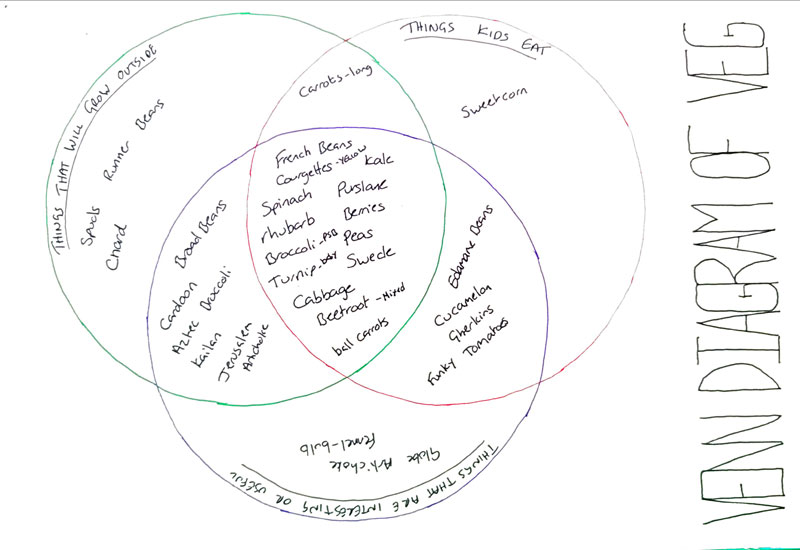
List of available resources
- Myself, mattocks, shovels & strength
- Time
- Currant bush cuttings
- Gooseberry cuttings
- Jerusalem Artichoke Tubers
- Cardoon seeds
- Lovage
- Japanese quince seedlings
- Vegetable seeds
- Top soil
- Horse Manure (from neighbours)
- Strawberry plants (from neighbours)
- Lupin seedlings
- Fruit trees (move from existing positions)
- Loganberry, move from existing position
- Weed supressing membrane
- Wooden Pallets
Water
The ground is hard and rocky, and the layer of topsoil close to non-existant, large swale type structures will not be possible to achieve without the use of machines. I could however create mini-swales along the contour and use the berms to grow on. The smaller swales would also interfere less with the natural flow of water down hill as the site is above a steeply sloping Hazel plantation.
Wind
Providing shelter will be my biggest challenge. I considered using a wind protection mesh, but the slope of the site, the cost of the material and the relevant fencing needed meant that this was not an appropriate choice for this project. I already have Hazel trees planted in the coppice field and some mixed trees at the edge of the coppice field/veg plot. The taller trees and medium height shrubs should provide shelter from the wind, and shadier microclimates in a very exposed location.
I have access to Pallets , these could be used to build a pallet barrier that will provide some wind protection. I have access to crop netting and build-a-ball frames that could provide more immediate protection for annual crops (from pests as well as wind)
Soil
The current soil is thin and poor quality – not suitable for growing healthy veg. I will need to put effort into improving soil fertility. I have access to a ready supply of Horse and Cow manure and weeds and sometimes woodchip.
Planting
Companion Planting and guilds operate through a variety of mechanisms, which may sometimes be combined. Plants can provide a symbiotic relationship, attract beneficial insects, or be offered up as a sacrificial crop (e.g. nasturtiums attracting brassica loving white butterflies). Some companion plants help prevent pest insects or pathogenic fungi from damaging the crop, through chemical means, for example, the smell of the foliage of marigolds is claimed to deter aphids from feeding on neighbouring plants. A wide range of plants will be important in the site.
Decisions
Tools Used – Functions & Links (mind map), Basemap & Overlays
The analysis indicated that lack of water holding properties of the soil and the exposed position were my two biggest challenges.
Providing shelter from wind and keeping necessary water on site were the key to the design. I also needed to be able to build humus and create nutritious compost.
I also wanted to use what I had (or neighbours had) and to minimise buying in of other resources
I used Mollison & Slay’s principles to guide my design.
(a) Relative location ; (b) Each element performs many functions; (c) Each important function is supported by many elements; (d) Efficient energy planning: zone, sector & slope; (e) Using biological resources; small-scale intensive systems; inc plant & time stacking; (f) Accelerating succession and evolution; (g) Diversity inc. Guilds; (h) Edge effect; (i) Imagination and information intensive
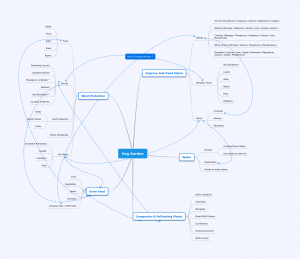
A ‘Forest Garden’ seems to tick all of these boxes. However, planting out and establishment of this system takes a long time and a significant amount of work, and my children love a lot of vegetables that need to be sown annually (and I like the magic of growing from seed). With this in mind I will incorporate elements of forest gardening with annual veg beds.
A Forest Garden is a garden modelled on a natural woodland. Like a natural woodland it has three layers of vegetation: trees, shrubs and herbaceous plants. In an edible forest garden the tree layer contains fruit and nut trees, the shrub layer soft fruit and nut bushes, and the ground layer perennial vegetables and herbs. The soil is not dug, and annual vegetables are not normally included unless they can reproduce by self seeding.
Patrick Whitefield, How To Make A Forest Garden 1996
The key features of a Forest Garden are:
- Increased Fertility – Using plants to increase fertility, such as nitrogen fixers. eg. Alders, Broom, Elaeagnus. The Nitrogen in the system enables higher production of fruit. (e, g, b)
- Dynamic accumulators – deep rooting plants which can tap mineral sources deep in the subsoil and raise them into the topsoil layer where they become available to other plants. When the plant is cut for mulch or dies, the nutrient rich leaves decompose and make the nutrients available to other plants with roots closer to the soil surface.eg. Coltsfoot, Comfreys, Liquorice, Sorrel (and docks!). (b, f, g, e, h, i)
- Stacking – Layering different root depths, or growing times, nutritional needs or sunlight requirements. (e, f, g, b, c, d, g)
- Insect attracting and repelling – The use of plants specially chosen for their ability to attract predators of common pests, eg umbellifers like Yarrow, also strong smelling plants that can help deter harmful insects. (a, b, c, d, e, g, h, i)
- Groundcover – to suppress grass and thereby increase fruiting in trees as well as protecting soil from leach of nutrients and soil erosion, good groundcover is essential. The plants can be chosen according to how much sunlight exposure they need and placed accordingly in the tree guilds. (a, b, c, d, e, f, g, h)
- Mulch material and leaf litter – Builds humus, protects the soil against erosion and evaporation of moisture and helps supress undesired plants. It also provides habitat and food for worms, insects, bacteria and fungi that help cycle nutrients and improve soil fertility. (c, d, e, f, g, h, i)
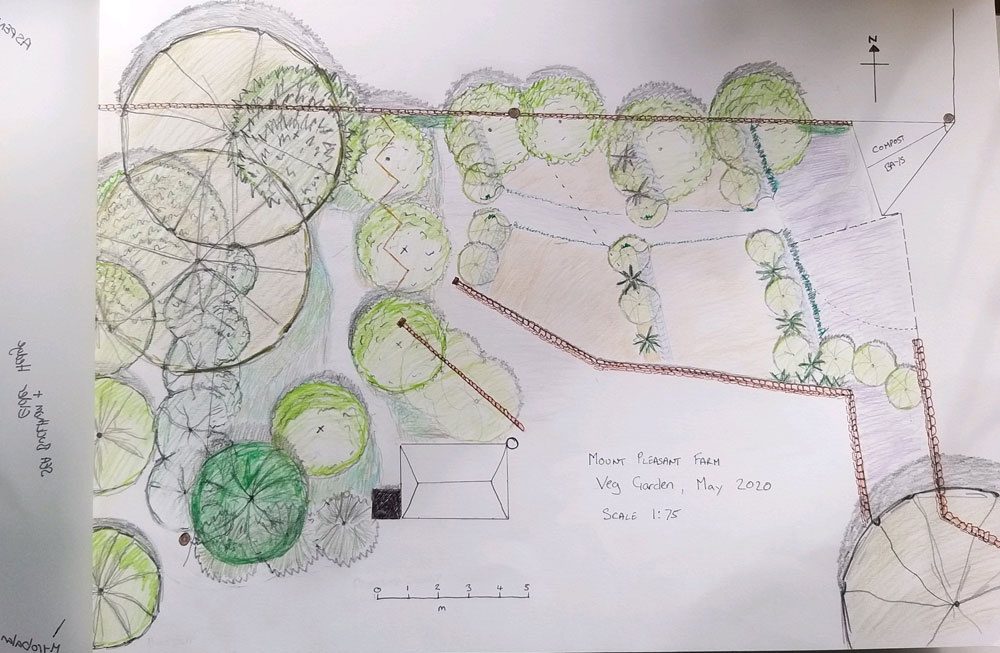
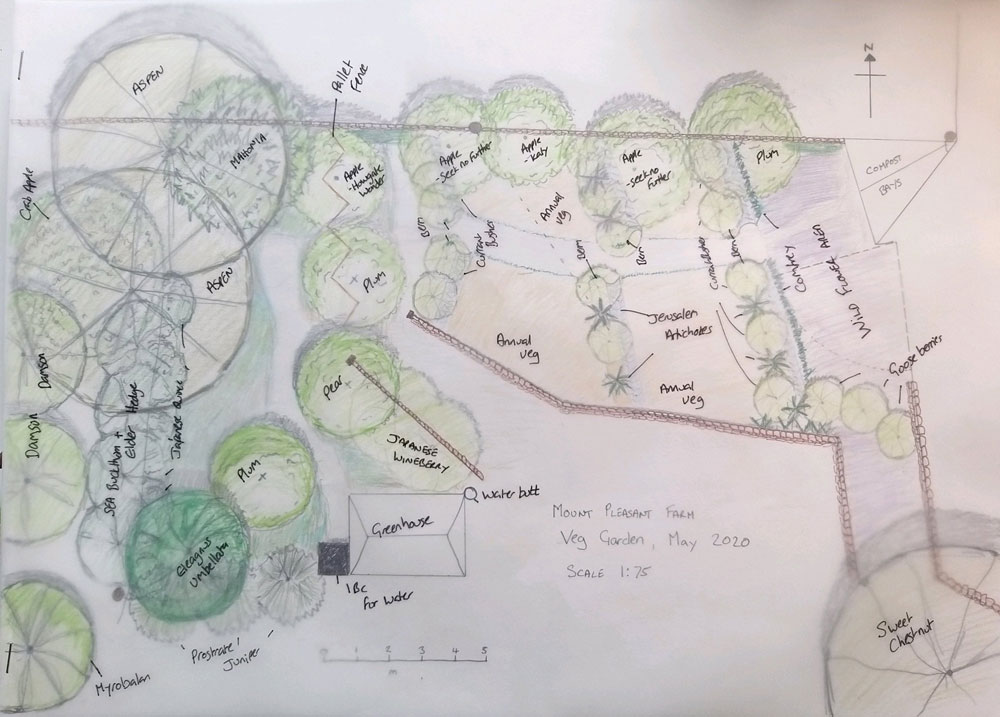
Water Management
To hold water on site I plan to use a series of mini-swales and berms (e, i, c, d) , plus mulch the site as much as possible. I will build mini-swales along the contour and use the berms to grow on.
I plan to plant guilds of fruits, vegetables and flowers on the berms. When the roots grow, they will hold the soil. The mix of plants ensures roots at different depths. The trenches will be planted with white clover to attract pollinators and act as a green mulch.
Wind Protection
The taller trees I plan to plant, or are currently on site and the medium height shrubs will provide shelter from the wind, and shadier micro climates in a very exposed location. (a, c, d, e, f, g, h, i)
In the short term, I propose to build a pallet barrier (a, b, d, i) that will provide some wind protection from the west. Protection from other directions will happen more slowly and will be provided by strategic planting.
My annual veg beds will be planted with shelter in mind. For example, taller vegetables such as Kales will provide wind protection for shorter plants. They will be planted in a way that maximises sunlight to other crops. Jerusalem Artichokes will also be planted on the berms to hold soil, offer wind protection and provide mulch material. (a, b, d, e, g, i)
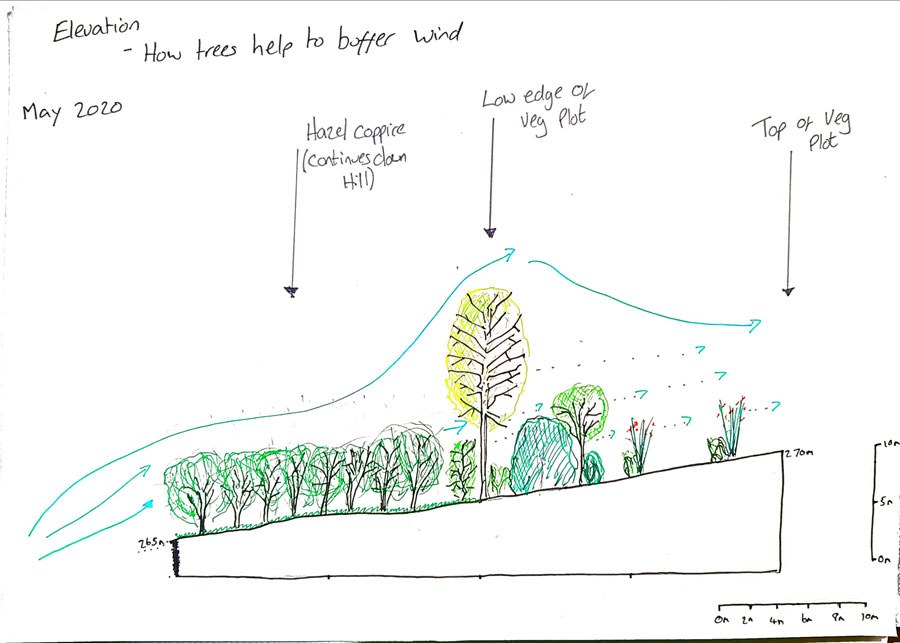
Decisions for larger trees and shrubs
The planting of larger trees and shrubs will provide shelter and structure to the site, and will define where and what else can be planted. (a, b, e, g)
| In Situ | |
|---|---|
| Aspen | Add a tall canopy, plenty of space underneath for planting, and makes a beautiful noise. |
| Sweet Chestnut | Adds a tall canopy, but will be coppiced for wood and to keep the size down as it is located near the road. Unlikely to produce edible fruits here. |
| Myrobalan | Just outside the garden area, but provides fruit and blossom |
| Crab Apple | On edge of garden area, provides blossom and fruit |
| Apple | Hardy varieties. Seek no Further, Katy and Howgate Wonder |
| Damson | Farleigh. Provides shelter, blossom and fruit |
| Hazel | Third Acre Hazel planted in field below for coppice/pollarding |
| Sea Buckthorn | On edge of garden. provides shelter, blossom and fruit. Nitrogen fixing. |
| Elder | On edge of garden, provides shelter, blossom and fruit |
| Japanese Quince | On edge of garden, provides shelter, early blossom and fruit |
| Proposed | |
|---|---|
| Plum | Provides shelter, blossom and fruit |
| Pear | Provides shelter, blossom and fruit. Self pollinating variety. |
| Eleagnus Umbellata | Large hardy shrub, vigorous. Good in exposed areas. Nitrogen fixing. Provides shelter, colour and fruit and scent. |
| Mahonia | Large hardy shrub. Provides shelter, fruit and colour. |
| Loganberry | Large sprawling fruit bush. Provides shelter and fruit. Moving from existing location |
| Jostaberry | Provides shelter and fruit |
| Japanese Wine Berry | Provides shelter and fruit |
| Currants | Provides shelter and fruit |
| Gooseberries | Provide shelter and fruit |
Feeding People
Using the Forest Garden idea, I envisage that crops grown will be a mix of perennial fruit vegetables and herbs which will be expanded over time.
My children also have a liking for many annual vegetables so, these will be incorporated. The annual vegetables will be planted in beds built on the contour (again to hold water), using the no-dig method. (a, b, d, g, i) The Venn Diagram of veg will help me decide on types and varieties. I have access to a Greenhouse & polytunnel to help with more protected growing areas.
Using a polyculture approach, planting flowers along side the veg, and mixing different veg and planting in different locations will enable me to observe what grows well in different spots, and also possibly confuse potential pests. (a, b, e, g, h, i)
Feeding Plants and Earth
The Forest garden approach focuses greatly on improving soil fertility through the use of Nitrogen fixing plants, leaf litter and mulch. I will use manure to build fertility and as plants start to grow, the leaf litter and dying green materials (that aren’t eaten) will either be used to make compost or left in situ. The compost can also be used to boost fertility in the undercover growing areas. Woodchip will also be used as mulch, especially around trees. (c, e, h)
Magic potions
As a child I used to love making magic potions. Not much has changed. I plan to use the abundant weeds that grow here to make compost teas to feed and boost the plants. Many weeds are high in trace elements and making teas from them enables other plants to more readily access these essential elements. I also plan to plant more comfrey which makes great plant food, and also attracts many beneficial insects. (a, b, e, g, h, i)
| Accumulator Plant | Trace Elelements |
|---|---|
| Yarrow | Phosphorus, Potassium, Calcium, Magnesium, Copper |
| Nettles | Nitrogen, Potassium, Calcium, Calcium, Iron, Copper, Sulphur |
| Comfrey | Nitrogen, Phosphorus, Potassium, Iron, Manganese |
| White Clover | Nitrogen, Sodium, Phosphorus, Molybendium |
| Dandelion | Calcium, Iron, Copper, Potassium, Magnesium, Sodium, Cobalt, Phosphorus |
| Garlic | Sulphur |
Nitrogen fixing plants
Nitrogen, Phosphorus and Potassium are the three nutrients that are needed by plants in the greatest quantity. Nitrogen is unique in that it is readily available in the air, and needs to be continually reintroduced to the soil. Certain plants have the ability to take Nitrogen from the air and store it. I plan to incorporate a number of these in my design. (a, b, c, e, g, i)
- Eleagnus – shade tolerant, hardy, fast growing and produces fruit
- White Clover – Living mulch, attracts pollinators
- Lupins – Look lovely, attracts pollinators
- Beans – Attract pollinators, Food
Companion Planting & Guilds
I will use a mix of plants across the site, inter-planting annual veg with flowers, and keeping some areas of nettles at the wall edge of the site. The nettles will provide food for insects, and also provide ingredients for compost teas. (a, b, c, e, g, i)
Fruit Tree Guild
The goal of a tree guild is to underplant a fruit or nut tree, with plants that are highly useful, multifunctional, and that might naturally be found growing together. Things to take into account when creating a tree guild are
Water – It will be drier closer to the tree as the tree uses a great quantity of water, however each tree will have a drip line (at the edge of its crown circumference), so this area will be comparitively wetter.
Sun/Shade – Plants that need a greater amount of sunlight should be located to the south, in full sun. Plants that prefer shade should be planted to the North.
Time – Mix early season growers will wither once the tree canaopy is in full leaf, but these can make space for plants that flourish later in the season
Functionality – Weed suppressing or ground cover plants and plants that fix nitrogen or are mineral accumulators are essential to the abundance of the garden.
Sources – https://www.tenthacrefarm.com/how-to-build-a-fruit-tree-guild/, How to make a Forest Garden, Patrick Whitefield
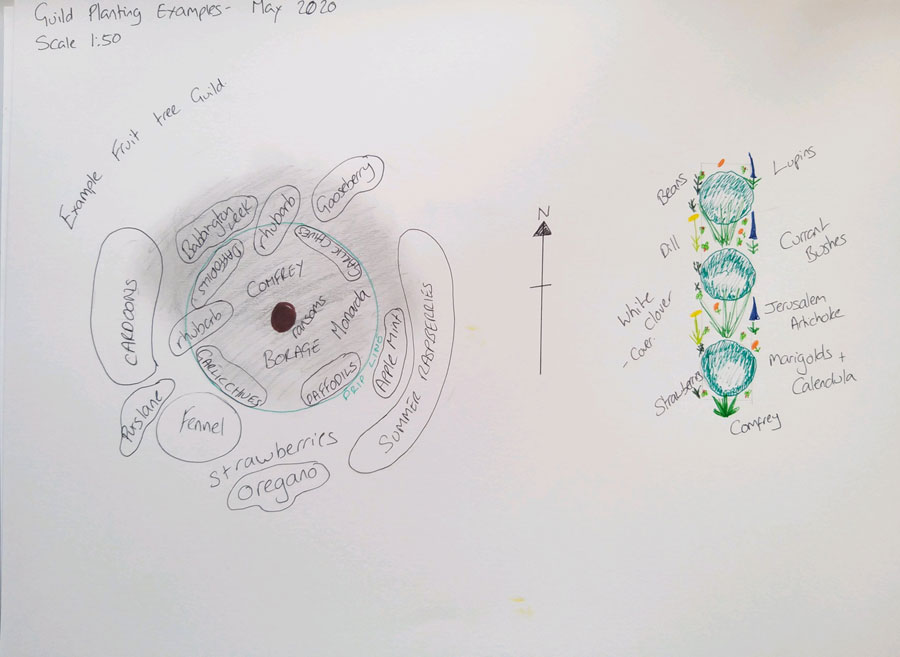
The berms are will be planted with many different plants. Because of their aspects one side of the berm received morning sun, but is shaded in the evening and vice-versa.
Taller plants and shrubs act as cross site protection. White clover acts as a living mulch, covering the soil. Lupins and beans fix Nitrogen, the strawberries act as ground cover and the Dill, Calendula and Marigolds attract polliantors.
Implementation and Maintenance Plan
Preparation Work – 2019
- Manure added in quantity and white clover sown & cut to build good quality soil.
- I know the site is exposed, trees and shrubs planted on the most exposed edge in 2018 and 2019.
- Build compost bays
- Use chickens to clear some of the weeds from the ground.
Spring 2020
- Use 2018’s fruitbush cuttings and existing tall plants to form multiple windbreaks, also plant Jerusalem Artichokes.
- Plant & move existing fruit trees
- To try to hold water on the site, and to create some microclimates, build a number of mini-swales. Due to the proximity of hard pan & rock, these swales won’t be very deep. The berms will be planted with a mix of plants to create wind breaks across the site and to hold the soil in place. The bottom of the swales will sown with white clover seeds which I had to hand.
- Construct no-dig on contour veg beds
- Sow wildflowers, calendula and nasturtiums and also plant comfrey roots to attract pollinators, provide biomass and hold soil.
Summer 2020
- Mulch new growing area for Autumn/Winter planting
- Build Pallet windbreak
- Plant some shrubs on windy edge behind greenhouse
Autumn/Winter 2020
- Move chickens to woods
- Construct 2nd Phase veg beds
- Install IBC to collect more water
- Plumb in water pipes that exist in Greenhouse – Andy
- Plant more fruit trees and bushes
2021/2022
Spring/Summer
- Continue to sow annual seed and plant out perennial plants
Winter
- Plant Remaining Fruit Trees (Gifted)
- Build Base for black water tank and IBC (Builder – Cost to be confirmed)
- Dig trench for electrics/water pipe to black tank
- Rebuild paths
- Install Willow retaining panels
2022/2023
- Create a sowing and harvesting record for the garden which will enable me to better analyse what crops are growing successfull, and perhaps most importantly are being eaten and used by the family.
- Build a community of ‘helpers’ who will share work and harvests. We will share the bounty and our knowledge.
- Create a timetable and record of compost tea brewing. Compare reults of applications on similar crops across the site from different teas.
Implement
Tools Used – A-Frame & Spirit Level frame.
The children and I wanted to try out different methods of finding the contour. We started with an A-Frame, but found that the wind blew the string and weight which was very irritating. We then built a frame for a spirit level and found the contours that way. We marked out the lines, which were then used to dig trenches and form berms.
The growing areas were covered with top soil (reserved from when we dug our pond), covered this with cardboard and then covered that in a thick layer of mature manure.
The more perennial ‘forest garden’ area was covered with a thick layer of wood chip on top of the manure and left for one season before planting. I also incorporated some feremented native microbes into the mix to boost soil fungal activity.
On one side of the plot, the annual veg growing areas were covered with black plastic for the first season to prevent weeds from seeding and supressing more vigorous weeds from growing.
Video showing the mini-swales – https://youtu.be/6XWnKf7KXwc
Trees and shrubs have been planted according to the design.
Willow harvested elsewhere on our land has been woven into windbreaks. These have gaps that filter the wind. They only protect plants at lower levels, but are enough to ensure these plants get a good start. whilst the trees and shrubs grow. Evegreen Honeysuckle has been planted so that it will grow and use the willow as a frame, further increasing the wind buffering effect.
Annual vegetables were sown and planted in the annual veg areas. They grew well, but were very much a trial to see what grew.
Costs/Inputs
- Labour – Use of local builder to transfer bulk manure to site £150
- Seeds – The majority of seeds and plants were from cuttings I made in previous years, seeds I had left or plants moved from elsewhere on the farm
- Shrubs and Trees – Using a local supplier of trees where possible. Max budget £150
- Time – I spent many days installing earth works and shovelling soil & manure/Compost
Maintain
Soil – Mulched the growing areas ready for the next growing season. I used rotted cow manure from a neighbours farm.
Trees and shrubs – Pruned and mulched trees and shrubs with wood chip. Checked trees for damage and cleaned anything that looked cankerous with methalated spirits
Currant Bushes – Pruned and took cuttings in the winter.
Gooseberry Bushes – Pruned and took cuttings in the winter.
Weed Control – Veg beds were weeded regularly. Perennial weeds are lessening.
Evaluate
Comments from passers by have been encouraging. They have enjoyed watching the site transform, as have I.
“I’ve been wandering past yours the odd time with the dog and looked over the wall at that little Mecca of growing. Truly beautiful work there Sara, and extraordinary considering the exposure on these hills. I keep meaning to knock on and commend you!”
Feedback from walker
What grew well?
Most things grew well, despite a strange growing season. It was a hot dry spring and a cold, wet summer. The cardoons are flourishing, and will form a great wind break. The Jerusalem Artichokes grew tall, but I will move them from the berms to the swales/ditches and along the eastern edge as I feel they will be more effective and stable in these positions (they were a bit too top heavy on the berms)
The Apple trees have recovered from their moves, as are the currant and berry bushes. Squashes were prone to mildew and we didn’t have too many courgettes. The Aztec Broccoli didn’t fare as well as it has in previous seasons, but I will try it again.
The Kales, brassicas and beetroots were fabulous!


How did Swales Perform?
I am still waiting for winter floods, but plants have been flourishing on the berms and across the site.
I think adding woodchip to the trenches to act as paths will be a next move.
Has Pallet windbreak helped?
Yes, it is proving to be a useful windbreak, it will be even better as plants are grown around it. The Tayberries and Japanese Wineberries look strong.
How has leaving wild patches around the edges worked?
This video taken in August says it all!
Water Saving
As yet the IBC and water tank remain uninstalled – this will happen this year (2022).
SMART Goals – Revisited
In 2022, I will have enough knowlege about the site to confidently host a group of volunteers. I aim to have group that meets weekly. I want the group to grow organically, through word of mouth and have at least 5 regular volunteers by the harvest season.
UPDATE: In March 2022 I launched Earth Mothers – a weekly gardening group. Advertised via Social Media, and through friends it has gained interest.
In 2022, I will start to keep proper crop & harvest records, as well as compost tea brews & applications, which will enable me to track my success (or otherwise). These will form the observations needed for plantings in years to come.
UPDATE: I have a decicated note book to make records in. It is more flexible and portable than a computer based solution.
By the end of 2023, I will produce enough fruit and vegetables from my plot that I will not need to order a regular veg bag, we will be self sufficient over the most productive months for most fruit and vegetables.
By 2024 I will be self sufficient in creating my own mulch for this growing area.
By 2025 I will better be able to see whether the trees I have planted to act as wind buffers are working. At this point I will be able to see what tweaks need to be made.
Tweak
I see Tweak as a version of Incremental Design. As I use the site and observe how things grow, I tweak the planting and shape of the site.
For example, the Jerusalem Artichokes are too tall and top heavy for berms. They also overtake the currant bushes, so they will slowly be removed. Try taller bean varieties – Experiment to see if wind protections are working.
2021 Update
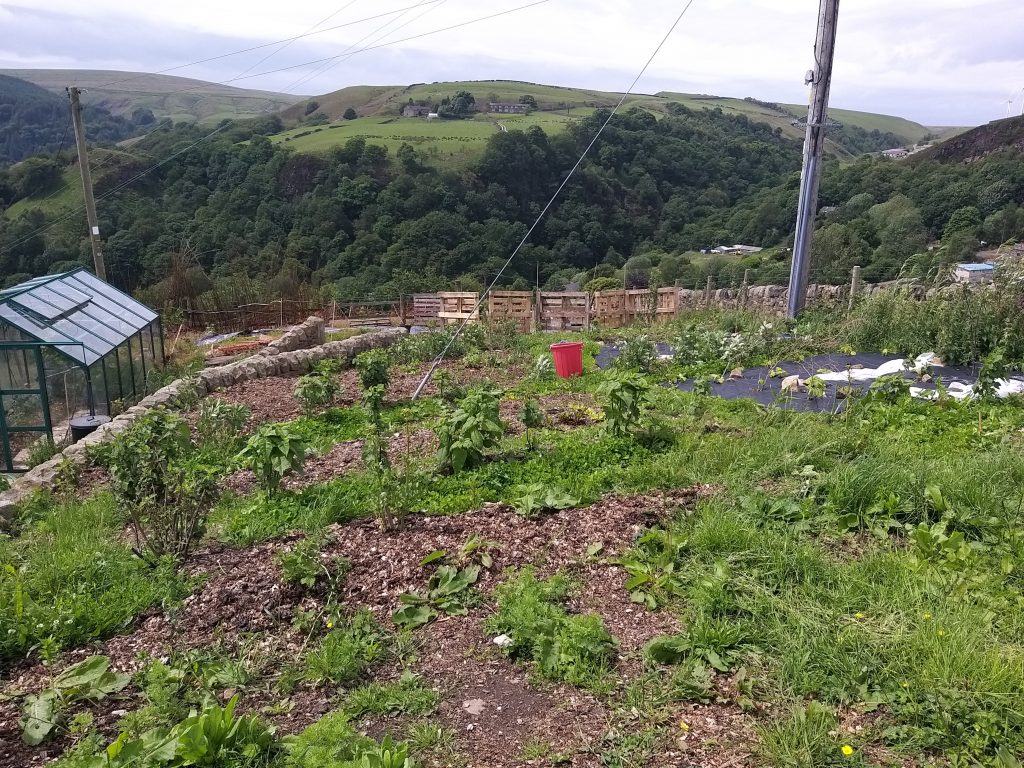
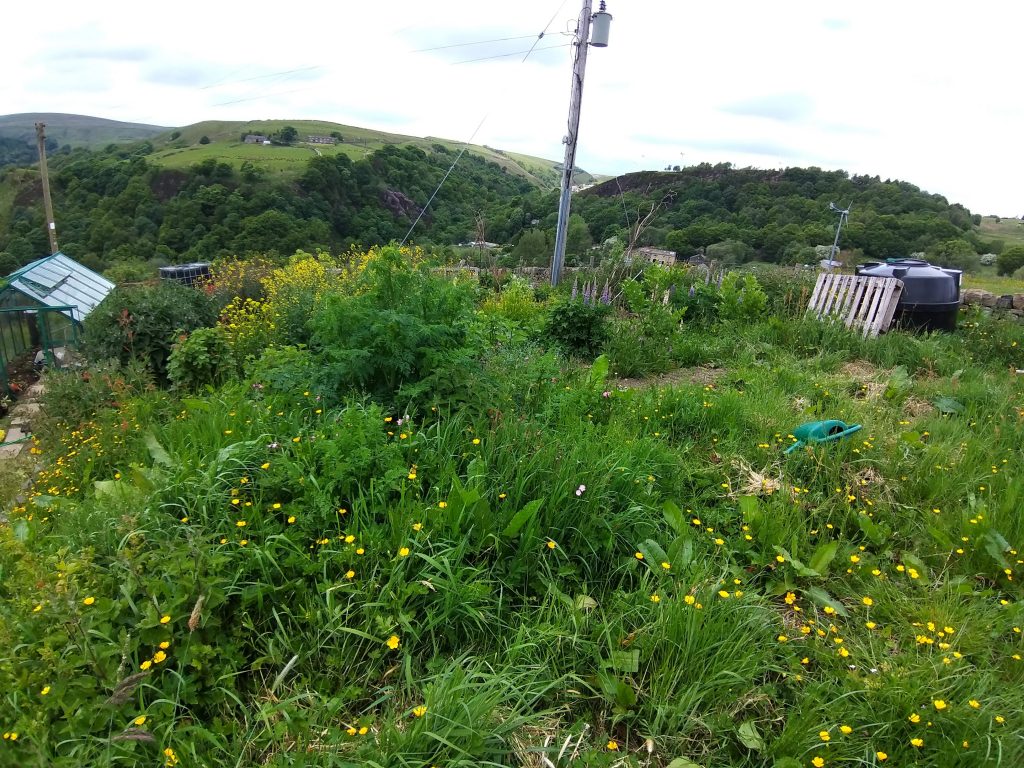
A year has passed since the site has been developed. A full cycle of sowing, planting and growing. Many lessons have been learned. I will be making the following changes:
- The berms need some support to define them from paths and capture any falling earth. I propose to make use of my abundant Willow and weave low retaining panels.
- I have a flat roof in my herb area, that initially was supposed to support a camomile lawn. The hot dry summers mean that the ‘lawn’ more often than not looks brown and shrivelled. Many of these camomile plants will be rehomed to the veg garden to make scented paths and provide more variety of ground cover (as well as a crop of camomile flowers).
- One of my apple trees didn’t make it – it will be replaced.
- I am considering swapping some of the wild nettles with Moroccan mint,
- I grew crops which never got eaten. I need to better plan my crop.
- I Let many plants go to seed and this seed has been harvested and saved to share with others (as well as using myself)
- I crammed far too many crops in together. I need to be less gung-ho
- The perennial sunflowers have been amazing, such a good windbreak and many magnificent flowers.
- Taller bean varieties faired well (those that didn’t get eaten by slugs or deer!)
- I need a Year Round Planting design!!!
- I have a been gifted a large water tank. Winter 2021 I hope to have this plumbed in at the top of the slope.
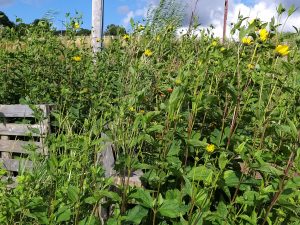
2022 Update
In Winter 2021/22 the Electricity board found a problem with a cable that unfortunately runs under this area. Until then, I never realised there was an underground cable as well as the over head one! A large portion of the site had to be excavated with heavy diggers, undoing all my hard work.
I have ordered a lot of mulch and in Spring 2022, will be starting work on rebuilding this design. A few tweaks may be made, but it will largly be following the original design.
One thing I do hope to explore is having a go at straw bail growing.
APPENDIX
List of proposed plants
Trees
- Pear
- Plum
Shrubs
- Eleagnus Umbellata
- Japanese Wineberry
- Mahonia
- Gooseberries
- Honeyberries
- Red Chokeberry
- Blueberries
- Raspberries
- White currants
Perennial Vegetables/Herbs
- Fennel
- Cardoons
- Babbington Leek
- Perennial Kale
- Rhubarb
- Borage
- Mint
- Bee Balm
- Jerusalem Artichoke
- Turkish Rocket
- Asparagus
- Garlic
- Salad Burnett
- Scorzonera
- Mitsuba
- Nine-star Broccoli
- Rocambole
- Angelica
- Perennial Sunflowers
- Inula Magnifica
Ground Cover / Low plants
- Garlic Chives
- Chives
- Calendula & Marigolds
- Daffodils
- Purslane
- Wild Strawberry
- Ajuga Reptans
- Comfrey
- Welsh Onion
- Primrose
- Violets
Reflection on the process
Tools Used
- A Frame & Spirit level – The A frame did not perform well with a breeze, despite quite a heavy weight. The Spirit level on a frame was much more user friendly.
- Base Maps & Overlays – A great way to work out how things fit together. If a change is needed, it is much easier to alter an overlay than it is to re-do an entire map.
- AH Contour Generator, was really easy to use. Having a clear visualisation of the contours helped in building the on-contour beds as I had a clear picture in my head of the shape of the land.
- McHargs Exclusion – When faced with a blank slate this helped shape the design as it enabled me to rule out certain ideas straight away.
- Sector SWOC – Chunking it down in this way made me consider everything in detail and think creatively at times.
- Venn Diagram of Veg – was fun to do, and also gave a clear picture of what types of things I should grow.
- Incremental Design – As I am working on this land constantly, I can tweak the design as I go if things aren’t working.
- Google Earth -I learned that mapping from Satellites does not take into account the extra land available from a slope. When measured physically the area is greater that appears from satellite images.
What have I learned from this design?
Sadimet was a good framework for this design. Chunking it down into specific stages helped to make me stop and think. I found it easier to think of D as decisions rather than design.
Knowing the site well it was tricky not to to have ideas influence my observations, I got round this by writing down any ideas and parking them for future reference. Some of these ideas made it to the plan, others didn’t.
Taking videos and photographs was a good way of recording observations.
I do tend to rush ahead with implementation. I need to learn to slow down.
I have stuck to budget! Saving seeds and swapping with friends has been very fruitful.
Reflecting on the design after a full 12 months of observing the site has been very beneficial. I better understand the site and the plants.
